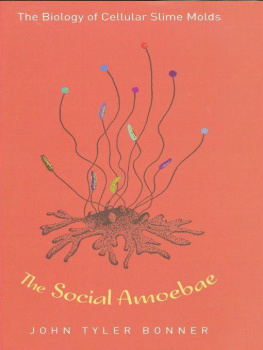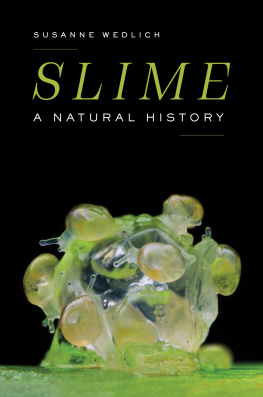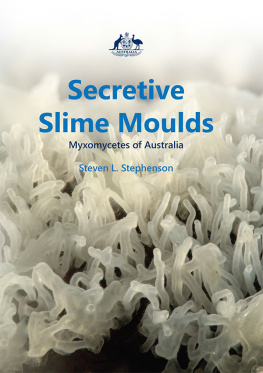Table of Contents
Copyright 2009 by Princeton University Press Published by Princeton University Press, 41 William Street,
Princeton, New Jersey 08540
In the United Kingdom: Princeton University Press, 6 Oxford Street, Woodstock, Oxfordshire OX20 1TW
All Rights Reserved
LIBRARY OF CONGRESS CATALOGING-IN-PUBLICATION DATA
Bonner, John Tyler.
The social amoebae : the biology of cellular slime molds / John
Tyler Bonner.
p. cm.
Includes bibliographical references and index.
ISBN 978-0-691-13939-5 (hardcover: alk. paper)
1. Acrasiomycetes. I. Title.
QKG35.A1BGG5 2009
579.52dc22
2008020569
British Library Cataloging-in-Publication Data is available
This book has been composed in Adobe Garamond
Printed on acid-free pauper.
press.princeton.edu
Printed in the United States of America
10 9 8 7 6 5 4 3 2 1
PREFACE
I have lived with my beloved slime molds for a long time, and now suddenly I find myself quite overcome by the vast amount of new facts that have accumulated to account for every stage, every step (however small) of their life cycle. In the late 1940s and early 1950s (1945 to 1951) an average 3.4 papers on cellular slime molds were published a year; now, over the past seven years, there is an average of 224 papers a year! We are in danger of drowning in facts.
This is what stimulated me to write this book. It is an exercise to clarify my own thoughts. As I wandered into thinking about it, I decided to write something that is aimed at the curious layperson if I could explain the complete picture to him or her then I would understand it myself. I plan to shed all unnecessary jargon and concentrate on what I think are the main issues, all the while trying to give a rounded and complete picture of the biology of cellular slime molds. At the same time I will ask where slime molds fit into all of biology and even how they might illuminate that vast subject.
This will be done by concentrating on all of their biology, including their molecular biology. I plan to give equal time to their evolution, their ecology, their behavior, both as single amoeba and as cell masses, and their development. Some of these subjects have made great advances using molecular techniques; others, by their very nature, have been virtually untouched by molecular biology.
It must be said right from the beginning that this is a very personal book: it is my view of slime molds, and my view of biology. Others would no doubt write a very different book, but I hope that my individual slant does not interfere with the story I want to tell. My prejudices will affect the emphasis, and often the choice of topics, but my wish is not to obscure the significance of cellular slime molds and all the lessons they have for us.
I will look at everything through the lens of a full-time biologist. That will include the contributions that molecular biology has made that illuminate basic living processes. There is an enormous difference between what was known when I published the second edition of my The Cellular Slime Molds in 1967 and what we know now: it is quite overwhelming. One need only look at Richard Kessins splendid book Dictyostelium, published in 2001, to again see in a dramatic way how rapidly the subject has advanced since 1967. And there have been many more new discoveries since his book was published.
The advances have been largely in the new molecular facts, and this is the reason there has been such a rapid turnover. It is my hope that, by looking at everything from a more generalized biological point of view, the lessons we have learned will last for some time.
One other difficulty in writing such a book is that there are scores of first-rate contributions that will not receive the credit, or even the mention, they deserve. This book is not an encyclopedia, a textbook, or a monograph; it covers only a fraction of all we know about slime molds. Rather, it is an essay on the big lessons we have learned, with a few unconventional and new insights. The details have been shed, fascinating though many of them are, and only the main plot is bared. Because of this I apologize to the many workers in the field whose fine work I have not mentioned, and some of them areor at least weregood friends!
None of the facts in this book are new: many are common knowledge and some may lie unnoticed under a rock. If there is any novelty it is in the way they are put together.
A number of kind friends were good enough to read earlier versions of this book and their corrections of errors and advice for improvements were of incalculable help to me. In particular I would like to thank Leo Buss, Edward Cox, Vidyanand Nanjundiah, and Pauline Schaap. I would also like to thank Mary Jane West-Eberhard for looking at one section of the book. Throughout the preparation of this book Slawa Lamont has sustained me with her encouragement and her support. Finally, I have been lucky enough to get the tremendous, skilled help from a number of individuals at the Princeton University Press; my special thanks to Alice Calaprice, Alison Kalett, Dimitri Karetnikov, and Deborah Tegarden.
INTRODUCTION
Evolution, cell biology, biochemistry, and developmental biology have made extraordinary progress in the last hundred yearsmuch of it since I was weaned on schoolboy biology in the 1930s. Most striking of all is the sudden eruption of molecular biology starting in the 1950s. I will make a reckless generalization that each one of these surges was due to a collision with genetics. Perhaps it would be more accurate to say that they fused rather than just collided, because in each case an extraordinary fruitful symbiosis was the result. First, at the beginning of this century, genetics fused with nineteenth-century cytology, which gave us an understanding of how the genetic material was handled in the chromosomes in mitosis, and particularly in meiosis. Next, genetics fused with Darwinian evolution to give rise to population genetics, a signal advance at the time. Then, with the revolution started by Watson and Crick on the molecular structure of the gene, it was possible, through molecular biology to (1) have a second fusion of genetics with cell biology, making it possible to dissect out the biochemical or molecular events within a cell; (2) to devise a new way of attacking phylogenetic problems in the study of evolution using molecular-genetic techniques; and finally (3), these new approaches made it possible to dissect out the sequence of molecular steps in development.
I am not done with my generalizations! During all the events I have described, there has been a strong tendency to concentrate on model organisms. In the past century there was a tremendous emphasis on E. coli, the fruit fly Drosophila, and the nematode worm Caenorhabditis, but beginning back into the nineteenth century there have been many others that have played a similar role. To mention a few, there was Mendel with his garden peas, followed by other organisms such as maize, amphibian, chick and sea urchin embryos, yeast, myxobacteria, zebra fish, the small plant Aribidopsis, and the cellular slime molds. One could add a few more and the list would still be incomplete: for instance, ciliate protozoa (such as Paramecium), Hydra and other hydroids, sponges, Volvox and other algae, myxomycetes or true slime molds, Phycomyces and other fungi, mice and other mammals. The degree to which these various examples have been directly affected by genetics and molecular biology varies, but even in those cases where the influence has been small (due to the lack of attention) this is beginning to change. In fact, one can say that it is inconceivable to study the biology today on any organism without genetics and molecular biology. For completeness it should be added that there is now renewed interest in another collision: the realization that evolution and developmental biology are inseparable, something that was already recognized by Darwin.









